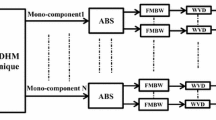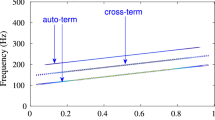Abstract
The Wigner–Ville distribution (WVD) is a signal processing approach to evaluate a high-resolution time–frequency representation (TFR) of a multi-component signal. The WVD of a multi-component signal produces unwanted cross-terms in the TFR. The elimination of these cross-terms using various signal processing techniques is a challenging research problem. In this paper, a data-driven signal decomposition technique is investigated for the elimination of these cross-terms in the WVD-based time–frequency representation of a multi-component signal. The approach is based on the decomposition of a multicomponent signal into its mono-components using sliding mode singular spectrum analysis (SM-SSA). The WVD of each mono-component is evaluated, and the sum of WVDs of all mono-components represents the cross-term free WVD representation of multi-component signals. Renyi entropy (RE) is used to quantify the performance of the proposed approach. Simulations are carried out using synthetic and real signals to verify the effectiveness of the proposed approach for the removal of cross-terms in WVD. The results demonstrated that SM-SSA has better performance with the lowest RE value as compared to other data-driven signal decomposition approaches such as automated SSA (AutoSSA) and swarm decomposition for the elimination of cross-terms from the WVD-based TFR of multi-component signals.









Similar content being viewed by others
Data Availability Statement
The signal files and the codes of the proposed work are available upon request to the authors.
References
K.T. Andersen, M. Moonen, Adaptive time-frequency analysis for noise reduction in an audio filter bank with low delay. IEEE/ACM Trans. Audio Speech Lang. Process. 24(4), 784–795 (2016)
G.K. Apostolidis, L.J. Hadjileontiadis, Swarm decomposition: a novel signal analysis using swarm intelligence. Signal Process. 132, 40–50 (2017)
B. Boashash, Time-Frequency Signal Analysis and Processing: A Comprehensive Reference (Elsevier, Amsterdam, 2003)
R.G. Baraniuk, P. Flandrin, A.J. Janssen, O.J. Michel, Measuring time-frequency information content using the Rényi entropies. IEEE Trans. Inf. Theory 47(4), 1391–1409 (2001)
N. Baydar, A. Ball, A comparative study of acoustic and vibration signals in detection of gear failures using Wigner–Ville distribution. Mech. Syst. Signal Process. 15, 1091–1107 (2001)
M. Bayram, R.G. Baraniuk, Multiple window time-frequency analysis, in Proceedings of Third International Symposium on Time-Frequency and Time-Scale Analysis (TFTS-96) (IEEE, 1996), pp. 173–176
B. Boashash, Time-Frequency Signal Analysis and Processing: A Comprehensive Reference (Academic Press, Cambridge, 2015)
R. Bousseljot, D. Kreiseler, A. Schnabel, Nutzung der ekg-signaldatenbank cardiodat der ptb über das internet. Biomedizinische Technik/Biomed. Eng. 40(s1), 317–318 (1995)
Y. Chai, X. Zhang, EMD-WVD time-frequency distribution for analysis of multi-component signals, in Fourth International Conference on Wireless and Optical Communications, vol. 9902 (International Society for Optics and Photonics, 2016), p. 99020W
V.C. Chen, H. Ling, Time-Frequency Transforms for Radar Imaging and Signal Analysis (Artech House, Boston, 2001)
S.H. Cho, G. Jang, S.H. Kwon, Time-frequency analysis of power-quality disturbances via the Gabor–Wigner transform. IEEE Trans. Power Deliv. 25(1), 494–499 (2009)
H.I. Choi, W.J. Williams, Improved time-frequency representation of multicomponent signals using exponential kernels. IEEE Trans. Acoust. Speech Signal Process. 37(6), 862–871 (1989)
V. Cizek, Discrete Hilbert transform. IEEE Trans. Audio Electroacoust. 18(4), 340–343 (1970)
T. Claasen, W. Mecklenbrauker, The Wigner distribution—A tool for time-frequency signal analysis. Philips J. Res. 35(3), 217–250 (1980)
V. Climente-Alarcon, J.A. Antonino-Daviu, M. Riera-Guasp, M. Vlcek, Induction motor diagnosis by advanced notch FIR filters and the Wigner–Ville distribution. IEEE Trans. Ind. Electron. 61(8), 4217–4227 (2013)
P. Dash, B. Panigrahi, G. Panda, Power quality analysis using s-transform. IEEE Trans. Power Deliv. 18(2), 406–411 (2003)
Y. Ding, W. He, B. Chen, Y. Zi, I.W. Selesnick, Detection of faults in rotating machinery using periodic time-frequency sparsity. J. Sound Vib. 382, 357–378 (2016)
P. Flandrin, O. Rioul, Affine smoothing of the Wigner–Ville distribution, in International Conference on Acoustics, Speech, and Signal Processing (IEEE, 1990), pp. 2455–2458
A. Gavrovska, V. Bogdanović, I. Reljin, B. Reljin, Automatic heart sound detection in pediatric patients without electrocardiogram reference via pseudo-affine Wigner–Ville distribution and Haar wavelet lifting. Comput. Methods Programs Biomed. 113, 515–528 (2014)
A.L. Goldberger, L.A. Amaral, L. Glass, J.M. Hausdorff, P.C. Ivanov, R.G. Mark, J.E. Mietus, G.B. Moody, C.K. Peng, H.E. Stanley, Physiobank, physiotoolkit, and physionet: components of a new research resource for complex physiologic signals. Circulation 101(23), e215–e220 (2000)
N. Golyandina, A. Zhigljavsky, Singular Spectrum Analysis for Time Series (Springer, Berlin, 2013)
J. Han, M. van der Baan, Empirical mode decomposition for seismic time-frequency analysis. Geophysics 78(2), O9–O19 (2013)
G. Hao, F. Tan, X. Hu, Y. Bai, Y. Lv, A matching pursuit-based method for cross-term suppression in WVD and its application to the ENPEMF. IEEE Geosci. Remote Sens. Lett. 16, 1304–1308 (2019)
J. Harmouche, D. Fourer, F. Auger, P. Borgnat, P. Flandrin, The sliding singular spectrum analysis: a data-driven nonstationary signal decomposition tool. IEEE Trans. Signal Process. 66(1), 131–136 (2018). https://doi.org/10.1109/TSP.2017.2752720
N.E. Huang, Z. Shen, S.R. Long, M.C. Wu, H.H. Shih, Q. Zheng, N.C. Yen, C.C. Tung, H.H. Liu, The empirical mode decomposition and the Hilbert spectrum for nonlinear and non-stationary time series analysis, in Proceedings of the Royal Society of London A: Mathematical, Physical and Engineering Sciences, vol. 454 (The Royal Society, 1998), pp. 903–995
S. Jain, R. Panda, R.K. Tripathy, Multivariate sliding mode singular spectrum analysis for the decomposition of multisensor timeserie. IEEE Sens. Lett. 4(6), 1–4 (2020)
A. Kareem, T. Kijewski, Time-frequency analysis of wind effects on structures. J. Wind Eng. Ind. Aerodyn. 90(12–15), 1435–1452 (2002)
N.A. Khan, M. Sandsten, Time-frequency image enhancement based on interference suppression in Wigner–Ville distribution. Signal Process. 127, 80–85 (2016)
N.A. Khan, I.A. Taj, M.N. Jaffri, S. Ijaz, Cross-term elimination in Wigner distribution based on 2D signal processing techniques. Signal Process. 91(3), 590–599 (2011)
F. Li, R. Li, L. Tian, L. Chen, J. Liu, Data-driven time-frequency analysis method based on variational mode decomposition and its application to gear fault diagnosis in variable working conditions. Mech. Syst. Signal Process. 116, 462–479 (2019)
Y. Li, Q. Liu, S.R. Tan, R.H. Chan, High-resolution time-frequency analysis of eeg signals using multiscale radial basis functions. Neurocomputing 195, 96–103 (2016)
Y. Li, M.L. Luo, K. Li, A multiwavelet-based time-varying model identification approach for time-frequency analysis of EEG signals. Neurocomputing 193, 106–114 (2016)
N. Liu, J. Gao, X. Jiang, Z. Zhang, Q. Wang, Seismic time-frequency analysis via STFT-based concentration of frequency and time. IEEE Geosci. Remote Sens. Lett. 14(1), 127–131 (2016)
D.P. Mandic, N. ur Rehman, Z. Wu, N.E. Huang, Empirical mode decomposition-based time-frequency analysis of multivariate signals: the power of adaptive data analysis. IEEE Signal Process. Mag. 30(6), 74–86 (2013)
Y. Meyer, Wavelets and Operators, vol. 1 (Cambridge University Press, Cambridge, 1992)
R.B. Pachori, A. Nishad, Cross-terms reduction in the Wigner–Ville distribution using tunable-q wavelet transform. Signal Process. 120, 288–304 (2016)
R.B. Pachori, P. Sircar, A new technique to reduce cross terms in the Wigner distribution. Digit. Signal Process. 17(2), 466–474 (2007)
C.R. Pinnegar, L. Mansinha, The s-transform with windows of arbitrary and varying shape. Geophysics 68(1), 381–385 (2003)
H. Ren, A. Ren, Z. Li, A new strategy for the suppression of cross-terms in pseudo Wigner–Ville distribution. SIViP 10(1), 139–144 (2016)
S. Sanei, T.K. Lee, V. Abolghasemi, A new adaptive line enhancer based on singular spectrum analysis. IEEE Trans. Biomed. Eng. 59(2), 428–434 (2011)
D.H. Schoellhamer, Singular spectrum analysis for time series with missing data. Geophys. Res. Lett. 28(16), 3187–3190 (2001)
E. Sejdic, L. Stankovic, M. Dakovic, J. Jiang, Instantaneous frequency estimation using the s-transform. IEEE Signal Process. Lett. 15, 309–312 (2008)
R.R. Sharma, A. Kalyani, R.B. Pachori, An empirical wavelet transform-based approach for cross-terms-free Wigner–Ville distribution. Signal Image Video Process. 14, 249–256 (2019). https://doi.org/10.1007/s11760-019-01549-7
R.R. Sharma, P. Meena, R.B. Pachori, Enhanced time-frequency representation based on variational mode decomposition and Wigner–Ville distribution, in Recent Trends in Image and Signal Processing in Computer Vision (Springer, 2020), pp. 265–284
R.R. Sharma, R. Pachori, Improved eigenvalue decomposition-based approach for reducing cross-terms in Wigner–Ville distribution. Circuits Syst. Signal Process. 37, 3330–3350 (2018). https://doi.org/10.1007/s00034-018-0846-0
H. Singh, R.K. Tripathy, R.B. Pachori, Detection of sleep apnea from heart beat interval and ECG derived respiration signals using sliding mode singular spectrum analysis. Digit. Signal Process. 104, 102796 (2020)
P. Sircar, S. Sharma, Complex FM signal model for non-stationary signals. Signal Process. 57(3), 283–304 (1997)
L. Stanković, A measure of some time-frequency distributions concentration. Signal Process. 81(3), 621–631 (2001)
L. Stankovic, M. Daković, T. Thayaparan, Time-Frequency Signal Analysis with Applications (Artech House, Boston, 2013)
R.G. Stockwell, L. Mansinha, R. Lowe, Localization of the complex spectrum: the s transform. IEEE Trans. Signal Process. 44(4), 998–1001 (1996)
R. Tripathy, M.R.A. Paternina, J.G. Arrieta, P. Pattanaik, Automated detection of atrial fibrillation ECG signals using two stage VMD and atrial fibrillation diagnosis index. J. Mech. Med. Biol. 17(07), 1740044 (2017)
R. Tripathy, L. Sharma, S. Dandapat, Detection of shockable ventricular arrhythmia using variational mode decomposition. J. Med. Syst. 40(4), 79 (2016)
R.K. Tripathy, M.R. Paternina, J.G. Arrieta, A. Zamora-Méndez, G.R. Naik, Automated detection of congestive heart failure from electrocardiogram signal using stockwell transform and hybrid classification scheme. Comput. Methods Programs Biomed. 173, 53–65 (2019)
D. Waldo, P.R. Chitrapu, On the Wigner Ville distribution of finite duration signals. Signal Process. 24(2), 231–237 (1991)
S. Wan, B. Peng, An integrated approach based on swarm decomposition, morphology envelope dispersion entropy, and random forest for multi-fault recognition of rolling bearing. Entropy 21(4), 354 (2019)
L. Wang, Z. Liu, Q. Miao, X. Zhang, Time-frequency analysis based on ensemble local mean decomposition and fast kurtogram for rotating machinery fault diagnosis. Mech. Syst. Signal Process. 103, 60–75 (2018)
W. Yang, Z. Peng, K. Wei, P. Shi, W. Tian, Superiorities of variational mode decomposition over empirical mode decomposition particularly in time-frequency feature extraction and wind turbine condition monitoring. IET Renew. Power Gener. 11(4), 443–452 (2016)
Funding
Funding was provided by Birla Institute of Technology and Science, Pilani (Grant No. FR/SCM/150618/EEE).
Author information
Authors and Affiliations
Corresponding author
Additional information
Publisher's Note
Springer Nature remains neutral with regard to jurisdictional claims in published maps and institutional affiliations.
Rights and permissions
About this article
Cite this article
Panda, R., Jain, S., Tripathy, R.K. et al. Sliding Mode Singular Spectrum Analysis for the Elimination of Cross-Terms in Wigner–Ville Distribution. Circuits Syst Signal Process 40, 1207–1232 (2021). https://doi.org/10.1007/s00034-020-01537-0
Received:
Revised:
Accepted:
Published:
Issue Date:
DOI: https://doi.org/10.1007/s00034-020-01537-0




